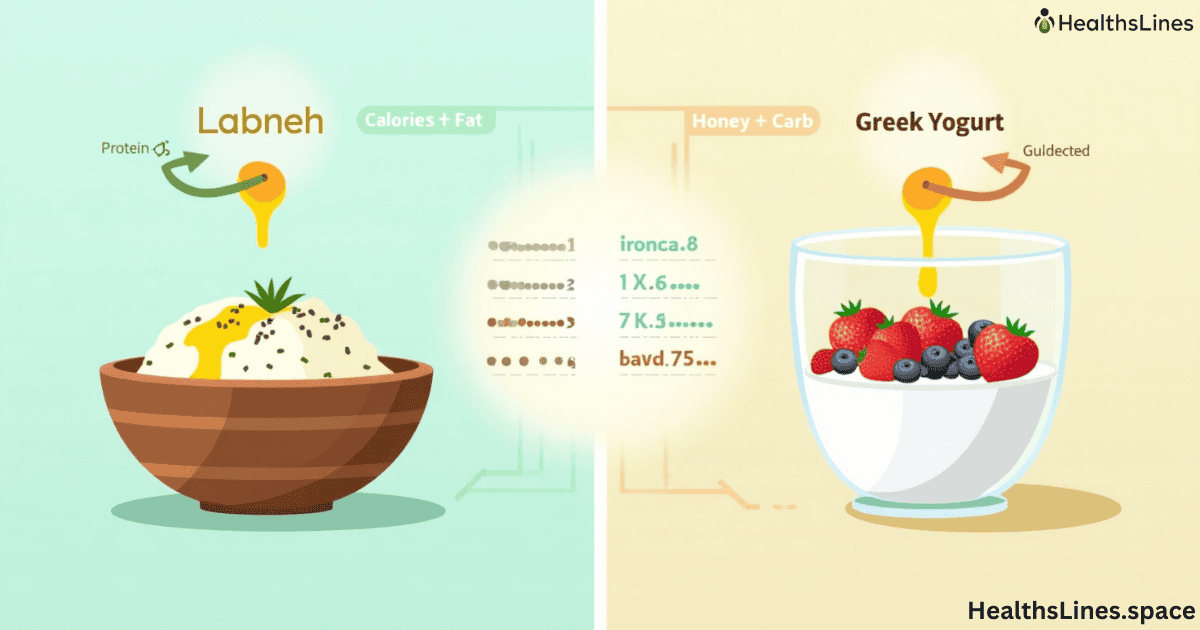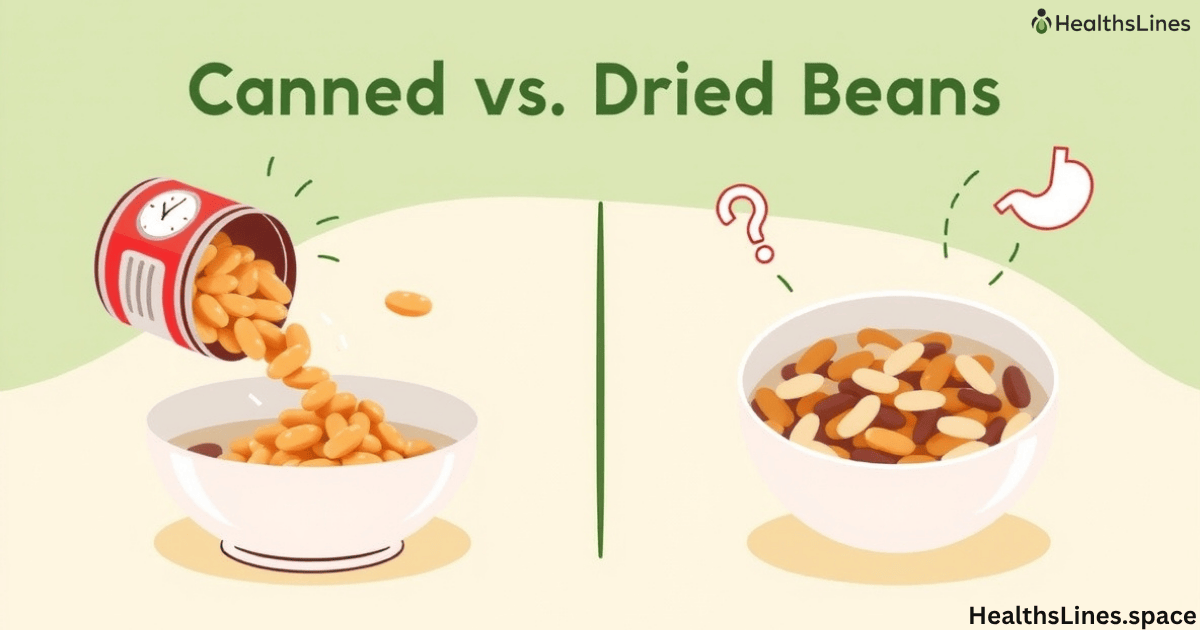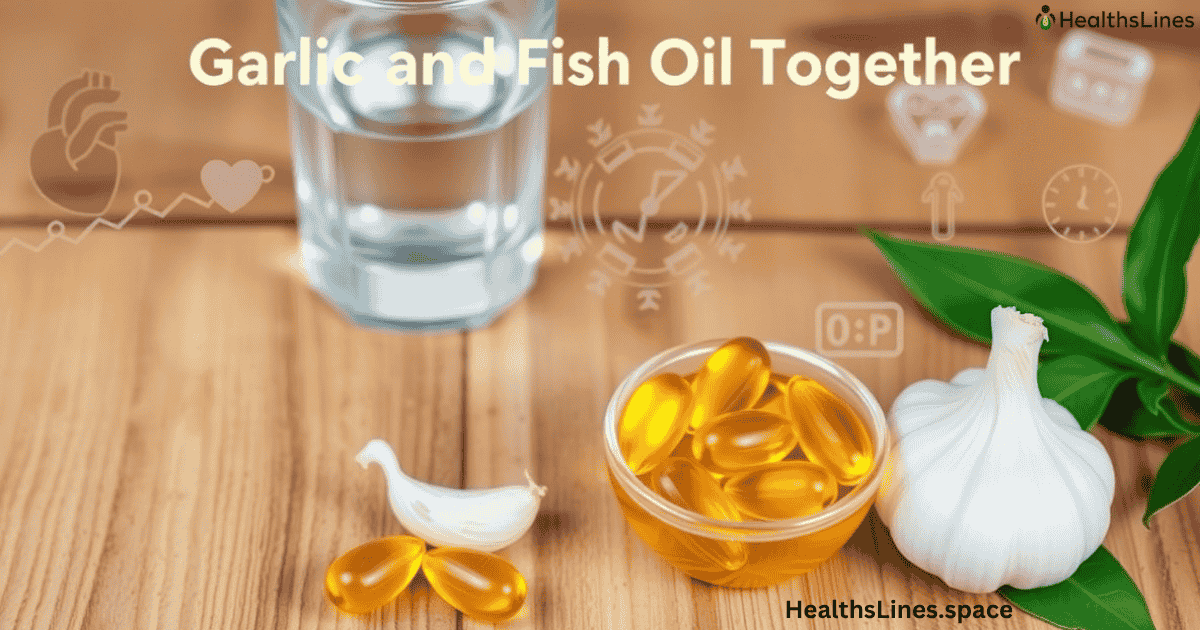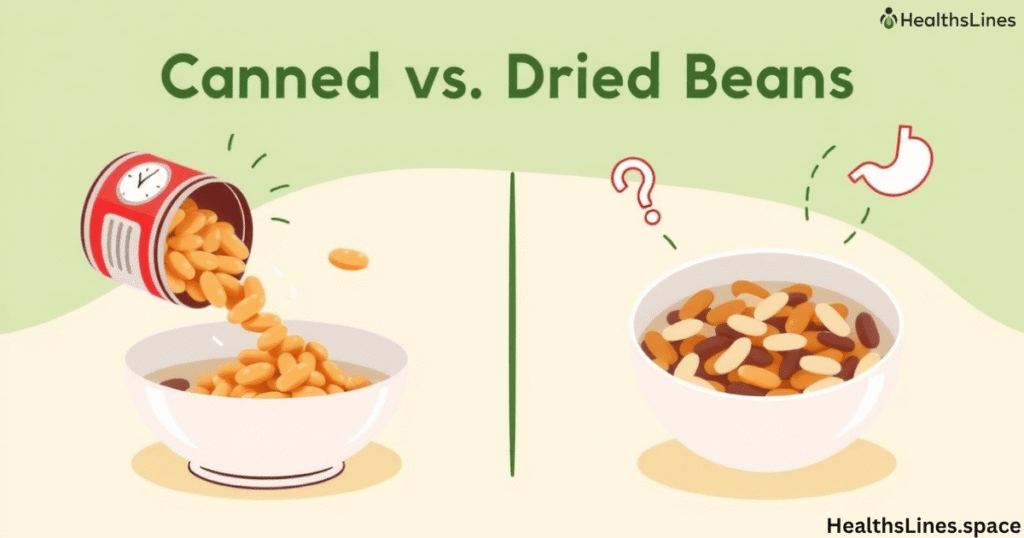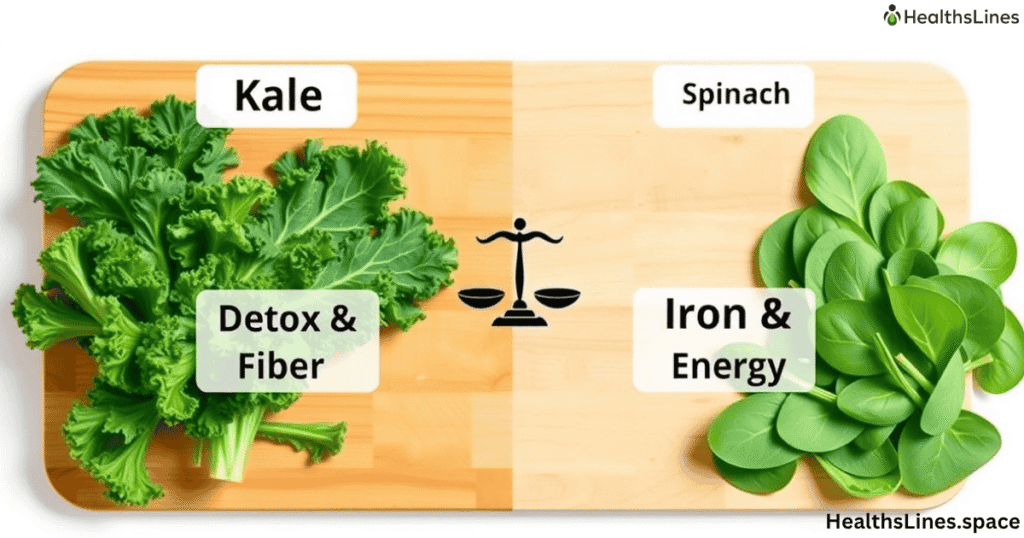Introduction
If you’ve ever stood in the dairy aisle, you’ve probably seen Greek yogurt sitting right next to labneh. At first, they may look alike, but they are not the same. They both come from strained yogurt, but they have very different textures, flavors, and nutrients. This is why many people wonder about labneh vs Greek yogurt and which one is better for protein and calories.
In this guide, we’ll explore labneh nutrition and Greek yogurt nutrition in detail. You’ll see how they compare in terms of protein, calories, fat, and other nutrients. You’ll also learn about their impact on gut health, heart health, and diet goals like weight loss or muscle gain. By the end, you’ll know which option best fits your lifestyle.
What Is Labneh?
Labneh is a creamy dairy spread that comes from the Middle Eastern labneh tradition. It’s made by straining yogurt until most of the water, or whey, is gone. This leaves behind a thick, soft cheese-like spread that’s tangy and smooth. It’s often eaten with pita bread, olive oil, or herbs, and it’s a big part of mezze platters in Mediterranean cuisine.
Because of the yogurt straining process, labneh becomes more nutrient-dense. It has higher amounts of fat and protein per serving compared to regular yogurt. Labneh protein is strong for a spread, and so are labneh calories. But another thing to note is salt. Sodium in labneh is often higher because salt is added during preparation. That makes it flavorful, but it can be a concern for people who need to watch their blood pressure or heart health.
What Is Greek Yogurt?
Greek yogurt comes from the same process of straining regular yogurt, but it’s not as thick as labneh. Instead of being spreadable, it’s spoonable, making it great for breakfast bowls, smoothies, or as a healthy snack on its own. It’s creamy but not as dense as labneh, and its tang is milder.
One reason Greek yogurt is so popular today is because of its nutrition. Greek yogurt protein is much higher than in regular yogurt, making it a great choice among high protein dairy foods. Many people looking for weight loss yogurt options choose low-fat Greek yogurt or non-fat Greek yogurt because it’s filling without adding many calories. That makes it a daily go-to in the Mediterranean diet yogurt lifestyle.
Protein Comparison: Labneh vs Greek Yogurt
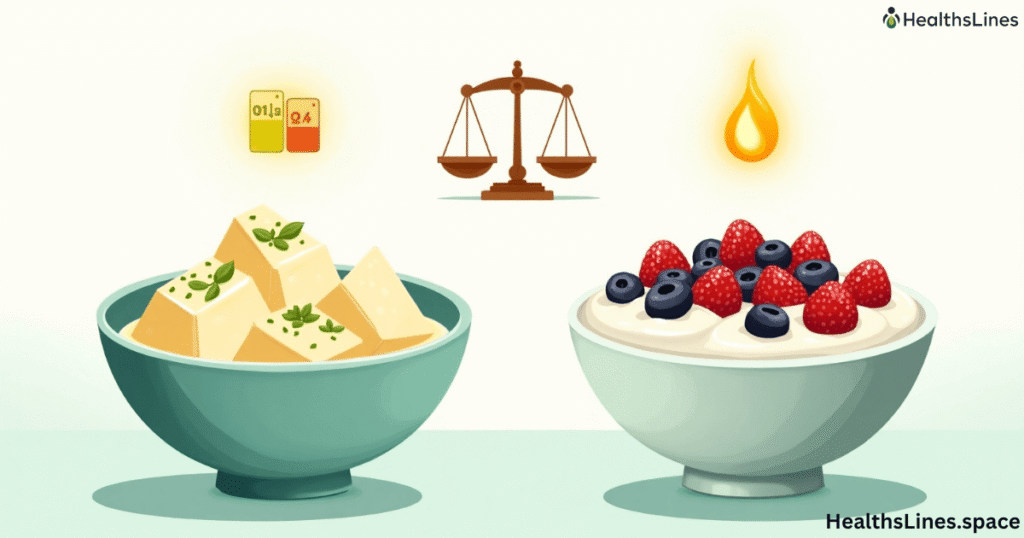
When people ask about labneh vs Greek yogurt, the first thing they want to know is which one has more protein. Protein is one of the most important nutrients in dairy, and both foods go through the yogurt straining process that increases protein levels. On average, Greek yogurt protein is about 10 grams per 100 grams, while labneh protein falls between 9 and 11 grams depending on how much liquid is removed. The numbers are close, but the way people eat them changes how much protein they actually get.
Greek yogurt is often eaten in bigger servings, like a full cup for breakfast, in smoothies, or as a snack. That makes it a better choice for people who want high protein dairy foods for muscle gain dairy foods or as part of weight loss yogurt options. Labneh, on the other hand, is richer and denser. It’s usually spread on bread or eaten with vegetables, which means people consume smaller amounts. Even though labneh nutrition includes plenty of protein, you might not eat enough to match a full serving of Greek yogurt. For athletes or anyone who needs a steady protein source every day, Greek yogurt nutrition makes it more practical. For flavor and richness in smaller bites, labneh works just as well.
Calories and Fat: Which One Packs More?
When it comes to calories, the story changes. Labneh calories are higher than Greek yogurt calories. Labneh has around 220 calories per 100 grams, while Greek yogurt usually has about 100 calories in non-fat Greek yogurt versions. This makes labneh a much more energy-dense food.
The reason is fat. Labneh fat content can be around 10 to 12 grams per 100 grams. Some of this is saturated fat in dairy, which can affect cholesterol and heart health and saturated fat levels. On the other hand, Greek yogurt fat content varies. You can find low-fat Greek yogurt with just 2 grams of fat, or non-fat Greek yogurt with almost none. That makes Greek yogurt more flexible for people watching calories or fat intake.
Salt and Additives: The Hidden Factor
One major difference in labneh vs Greek yogurt is the role of salt and additives. Traditional middle eastern labneh often includes salt as part of the preparation. This raises sodium in labneh, making it much higher than what you’ll usually find in plain Greek yogurt. Salt enhances the tangy flavor and helps preserve freshness, but too much sodium can become a concern. High sodium intake is linked to higher blood pressure and long-term heart health and saturated fat issues, especially when combined with other salty foods in your diet.
Greek yogurt, on the other hand, usually doesn’t contain added salt, which makes it a safer pick if you’re trying to cut down on sodium. But there’s another hidden factor: sugar. While plain Greek yogurt is simple and clean, many flavored versions add sweeteners, fruit syrups, or other fillers that increase calorie counts and reduce overall health benefits. This means the Greek yogurt nutrition you get depends heavily on which type you choose. If you stick with plain versions of either food, you’ll avoid the biggest concerns. In the end, labneh nutrition makes it richer in salt, while Greek yogurt nutrition may hide sugar if you go for flavored options. Choosing wisely ensures you get probiotics and protein without the drawbacks.
Gut Health and Probiotics
Both labneh and Greek yogurt provide probiotics, which are the good bacteria that help your digestive system work better. These probiotic benefits can improve digestion, boost immunity, and even support mood.
The straining process keeps probiotics alive in both, though the levels can vary. Labels that mention live cultures in yogurt are a sign that probiotics are active. This makes both labneh and Greek yogurt good choices for gut health and probiotics, especially compared to non-strained dairy spreads or processed cheeses.
Which One Fits Your Diet Best?
When deciding between labneh vs Greek yogurt, the right choice depends on your health goals. If you’re aiming for weight control, Greek yogurt nutrition often works better. It’s lower in calories, especially when you pick low-fat Greek yogurt or non-fat Greek yogurt, and it’s packed with protein that keeps you full. This makes it one of the best weight loss yogurt options. It also fits into smoothies, breakfast bowls, or eaten plain, giving you a flexible and light way to enjoy dairy without going over your calorie target.
Labneh, on the other hand, has its own strengths. Labneh nutrition makes it richer in calories and fat, which can be useful if you need more energy in smaller portions. It also works as a healthier replacement in the labneh vs cream cheese debate because it provides protein and probiotics without being as processed as cream cheese. People who follow traditional Mediterranean diet yogurt habits enjoy labneh with olive oil and herbs, making it a flavorful part of balanced meals. For athletes, Greek yogurt may be better for daily protein, while labneh works best when you want a filling spread that adds variety and taste to your plate. Both are healthy; it’s all about your personal diet goals.
Nutrition Comparison Table
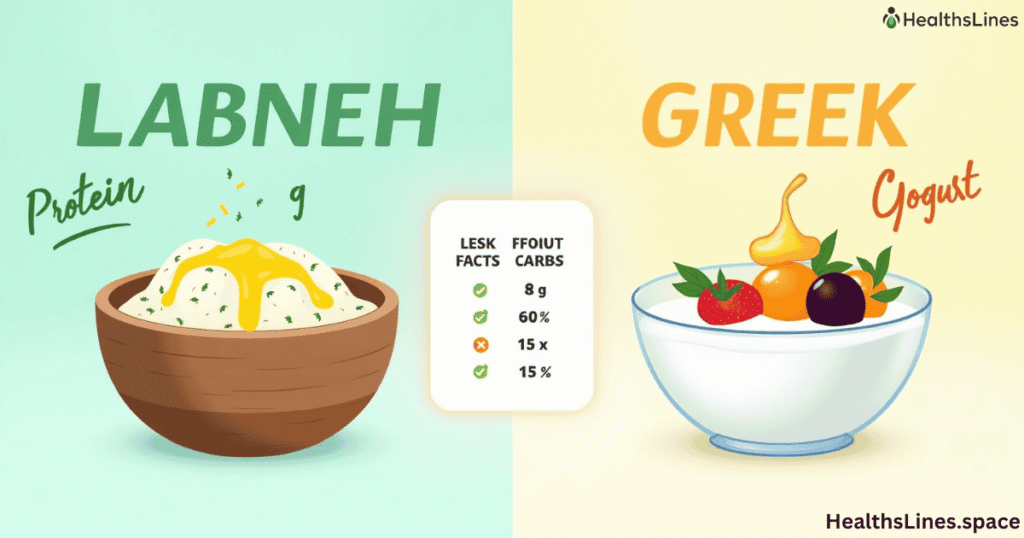
Here’s a simple table showing how labneh and Greek yogurt compare:
| Nutrient (per 100g) | Labneh | Greek Yogurt |
| Calories | ~220 | ~100 (non-fat) |
| Protein | ~9–11 g | ~10 g |
| Fat | ~10–12 g | ~0–4 g (varies by type) |
| Sodium | Higher (salt added) | Lower, unless flavored |
| Probiotics | Yes | Yes |
| Calcium | Good source | Good source |
This table shows why labneh nutrition makes it rich and dense, while Greek yogurt nutrition makes it light and flexible. Both give you protein, calcium, and probiotics, but the calorie and fat levels are what really set them apart.
Case Study: Dietician’s Experience
A dietician working with clients compared calories in dairy spreads with yogurts. She found that when people replaced labneh with non-fat Greek yogurt, they lost weight more easily because they cut calories while keeping probiotic benefits.
However, some clients who needed more calories for energy or weight gain found labneh more helpful. The higher labneh fat content and labneh calories gave them extra energy without eating too much food. The dietician concluded that neither labneh nor Greek yogurt is better for everyone. The right choice depends on your health goals.
Conclusion
The debate of labneh vs Greek yogurt comes down to what you need in your diet. Greek yogurt nutrition makes it a top choice for weight control, protein intake, and versatility. It’s a strong option among weight loss yogurt options and muscle gain dairy foods. On the other hand, labneh nutrition makes it richer, creamier, and better as a spread. It’s a smart swap for labneh vs cream cheese when you want something healthier.
Both foods bring value to the table. Labneh offers flavor, density, and tradition, while Greek yogurt brings lightness, balance, and flexibility. If you want fewer calories and more protein, choose Greek yogurt. If you want a flavorful spread with higher energy, labneh is your winner.
